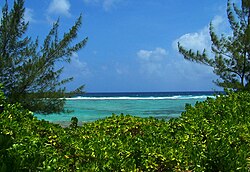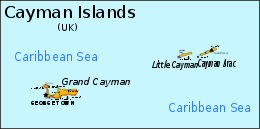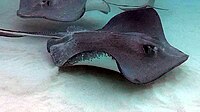Cayman Islands: Difference between revisions
No edit summary |
No edit summary |
||
| (One intermediate revision by the same user not shown) | |||
| Line 2: | Line 2: | ||
|name=Cayman Islands | |name=Cayman Islands | ||
|status=British Overseas Territory | |status=British Overseas Territory | ||
|picture= | |picture=Caribbean Ocean view from Bodden Town.jpg | ||
|picture caption= | |picture caption=Bodden Town, Grand Cayman | ||
|flag=Drapeau CYM.svg | |flag=Drapeau CYM.svg | ||
|arms=Héraldique CYM.svg | |arms=Héraldique CYM.svg | ||
|map= | |map image=Cayman Islands location detail.svg | ||
|motto="He hath founded it upon the seas" | |motto="He hath founded it upon the seas" | ||
|capital=[[George Town, Cayman Islands|George Town]] | |capital=[[George Town, Cayman Islands|George Town]] | ||
| Line 86: | Line 86: | ||
===Tourism=== | ===Tourism=== | ||
[[File:Seven Mile Beach 2006.jpg|1400px|Panorama of Seven Mile Beach, Grand Cayman]] | [[File:Seven Mile Beach 2006.jpg|1400px|Panorama of Seven Mile Beach, Grand Cayman]] | ||
{{clear}} | |||
One of [[Grand Cayman]]'s main attractions is Seven Mile Beach, on which a number of the island's hotels and resorts are located. Historical sites in GCM, such as Pedro St James Castle in Bodden Town, also attract visitors. Tourists also visit the Sister Islands, Little Cayman<ref>"This week's dream: diving and lazing on Little Cayman", (29 November 2008) ''The Week'' p. 39, Dennis Publishers, UK</ref> and Cayman Brac.<ref>Skip Harper, "Adventuring in Cayman Brac",Head and Toe Publishers, Fort Collins, Colorado, USA, 2001, ISBN 9780-9640645-2-2</ref> | One of [[Grand Cayman]]'s main attractions is Seven Mile Beach, on which a number of the island's hotels and resorts are located. Historical sites in GCM, such as Pedro St James Castle in Bodden Town, also attract visitors. Tourists also visit the Sister Islands, Little Cayman<ref>"This week's dream: diving and lazing on Little Cayman", (29 November 2008) ''The Week'' p. 39, Dennis Publishers, UK</ref> and Cayman Brac.<ref>Skip Harper, "Adventuring in Cayman Brac",Head and Toe Publishers, Fort Collins, Colorado, USA, 2001, ISBN 9780-9640645-2-2</ref> | ||
| Line 125: | Line 126: | ||
{{reflist}} | {{reflist}} | ||
* {{cite web | * {{cite web | ||
|url=https://www.cia.gov/library/publications/the-world-factbook/geos/cj.html | |url=https://www.cia.gov/library/publications/the-world-factbook/geos/cj.html | ||
Latest revision as of 08:27, 5 April 2020
| Cayman Islands (British Overseas Territory) | |
 Bodden Town, Grand Cayman | |
|---|---|

| |

| |
| "He hath founded it upon the seas" | |
| Area: | 102 square miles |
| Population: | 54,878 (2010) |
| Capital: | George Town |
| Time zone: | GMT -5 |
| Dialling code: | +1-345 |
| TLD: | .ky |
The Cayman Islands are three islands in the western Caribbean Sea together constituting a British overseas territory.
The three islands, Grand Cayman, Cayman Brac and Little Cayman, lie south of Cuba and northwest of Jamaica, within the Greater Antilles. Though small, the territory is a major world offshore financial centre.[1]
The capital of the Cayman Islands is George Town, on the southwest coast of Grand Cayman.
History
The Cayman Islands were first logged as sighted by Christopher Columbus on 10 May 1503 during his fourth and final voyage to the New World. He named the islands Las Tortugas after the large number of sea turtles observed there. The first recorded English visitor to the islands was Sir Francis Drake in 1586. He subsequently named the islands "Cayman" after the word caiman, the Carib word for "alligator".
The Cayman Islands remained largely uninhabited until the 17th century. While there is no archaeological evidence for an indigenous people on the islands, a variety of settlers made their home on the islands. This grouping of people from various backgrounds included pirates, refugees from the Spanish Inquisition, shipwrecked sailors, and deserters from Oliver Cromwell's army in Jamaica.

The first recorded permanent inhabitant of the Cayman Islands, Isaac Bodden, was born on Grand Cayman around 1661. He was the grandson of the original settler named Bodden who was probably one of Oliver Cromwell's soldiers at the taking of Jamaica in 1655.
England took formal control of the Cayman Islands, along with Jamaica, under the Treaty of Madrid in 1670. Following several unsuccessful attempts at settlement, residency in the islands began in the 1730s. With settlement came the need for slaves to work the new plantations and many were brought to the islands from Africa; the majority of native Caymanians today are of African or English descent or of mixed race. The first census taken in the islands was in 1802 and showed a population on Grand Cayman of 933, of whom 545 were slaves. Slavery was abolished in throughout the British Empire in 1834, at which time there were over 950 slaves, owned by 116 Caymanian families.
The islands continued to be governed as a single colony with Jamaica until 1962 when they became a separate Crown colony while Jamaica became an independent Commonwealth realm.
A legend abroad in these tax-free islands concerns the shipwreck of a convoy in the days of King George III. On 8 February 1794, the Caymanians rescued the crews of a group of ten merchant ships and their escort, HMS Convert, an incident that has since become known as the Wreck of the Ten Sail. The ships had struck a reef and run aground during rough seas. Legend has it that the King rewarded the island with a promise never to introduce taxes, since one of the ships carried a member of the King's own family, his son Prince William (later King William IV). It remains a popular legend, but alas is untrue.
On 11–12 September 2004, Grand Cayman was struck by Hurricane Ivan. The islands lie largely unprotected at sea level, and the storm surge completely over-washed Grand Cayman; an estimated 95% of the buildings on the island were either damaged or destroyed. Power, water and communications were disrupted in some areas for months as Ivan was the worst hurricane to hit the islands in 87 years. Grand Cayman began a major rebuilding process and within two years, its infrastructure was nearly returned to pre-hurricane status. Due to the tropical location of the islands, more hurricane or tropical systems have affected the Cayman Islands than any other region in the Atlantic basin; it has been brushed or directly hit, on average, every 2.23 years.[2]
Geography

The Cayman Islands are the peaks of a massive underwater ridge, known as the Cayman Ridge (or Cayman Rise). This ridge flanks the Cayman Trough, 3,000 fathoms deep which lies 4 miles to the south.[3] The islands lie in the northwest of the Caribbean Sea, south of Cuba and west of Jamaica.
| Island | Area (sq miles) | Population |
|---|---|---|
| Grand Cayman | 75.7 | 52,601 |
| Little Cayman | 11 | 170 |
| Cayman Brac | 15 | 1,800 |
All three islands were formed by large coral heads covering submerged ice age peaks of western extensions of the Cuban Sierra Maestra range and are mostly flat. One notable exception to this is The Bluff on Cayman Brac's eastern part, which rises to 141 feet above sea level, the highest point on the islands.
Terrain is mostly a low-lying limestone base surrounded by coral reefs.
Beasts and birds
There are ten mammalian species in the islands.
- Birds:
- Amazona leucocephala hesterna (Cayman Brac Parrot), native only to Cayman Brac
- Amazona leucocephala caymanensis (Grand Cayman Parrot), native to the Cayman Islands, forested areas of Cuba, and the Isla de la Juventud.
- Booby Birds on Cayman Brac
- Animals
- Blue Iguana, endemic to Grand Cayman.[4]
- Central American agouti
.[5]
People and business
The Cayman Islands have more registered businesses than they have people.[6]
The latest population estimate of the Cayman Islands is about 55,700 as of 2009, representing a mix of more than 100 nationalities. Out of that number, about half are of Caymanian descent. About 60% of the population is of mixed race (mostly mixed African-European). The islands are almost exclusively Christian, with large numbers of Presbyterians and Roman Catholics. The vast majority of the population resides on Grand Cayman, followed by Cayman Brac and Little Cayman, respectively.
With an average income of around KYD$47,000, Caymanians have the highest standard of living in the Caribbean. The islands print their own currency, the Cayman Islands Dollar (KYD), which is pegged to the US dollar at a fixed rate of 1 KYD=1.20 USD.[7]
The government's primary source of income is indirect taxation: there is no income tax, capital gains tax nor corporation tax. An import duty of 5% to 22% (cars 29.5% to 100%) is levied against goods imported into the islands. Just a few goods are exempt; books, cameras and infant formula specifically.
Tourism
One of Grand Cayman's main attractions is Seven Mile Beach, on which a number of the island's hotels and resorts are located. Historical sites in GCM, such as Pedro St James Castle in Bodden Town, also attract visitors. Tourists also visit the Sister Islands, Little Cayman[8] and Cayman Brac.[9]

All three islands offer scuba diving, and the Cayman Islands are home to several snorkeling locations, where tourists can swim with stingrays. The most popular area to do this is Stingray City, Grand Cayman.
There are two shipwrecks off the shores of Cayman Brac, including one sunk deliberately: the MV Keith Tibbetts to provide a diving site. Grand Cayman has several shipwrecks including the USS Kittiwake, decommissioned from the US Navy in 1994 and bought by the islands' government in November 2008 to be sunk to form a new artificial reef. She was sunk off Seven Mile Beach on 5 January 2011.
Other Grand Cayman tourist attractions include the Ironshore landscape of Hell, the 23 acre marine theme park Boatswain's Beach, also home of the Cayman Turtle Farm, the making of "gourmet" sea salt, and the Mastic Trail, a hiking trail through the forests in the centre of the island. The National Trust for the Cayman Islands provides guided tours weekly on the Mastic Trail and other locations.[10]
The East End Light (sometimes called Gorling Bluff Light) is a lighthouse located at the east end of Grand Cayman island in the Cayman Islands. The lighthouse is the centrepiece of East End Lighthouse Park, managed by the National Trust for the Cayman Islands; the first navigational aid on the site was the first lighthouse in the Cayman Islands.
Financial services industry
The Cayman Islands are a major international financial centre. The biggest sectors are banking, hedge fund formation, off-shore funds, structured finance and securitization, captive insurance, and general corporate activities. Regulation and supervision of the financial services industry is the responsibility of the Cayman Islands Monetary Authority (CIMA).
The Cayman Islands are the fifth-largest banking centre in the world,[11] with $1.5 trillion in banking liabilities. There are 279 banks (as of June 2008), 19 of which are licensed to conduct banking activities with domestic (Cayman-based) and international clients, the remaining 260 are licensed to operate on an international basis with only limited domestic activity. Financial services generated CI$1.2 billion of GDP in 2007 (55% of the total economy), 36% of all employment and 40% of all government revenue. In 2010, the country ranked fifth internationally in terms of value of liabilities booked in the Cayman Islands and sixth in terms of assets booked. It has branches of 40 of the world’s 50 largest banks. The Cayman Islands are the second largest captive domicile in the world with more than 700 captives, writing more than US$7.7 billion of premiums and with US$36.8 billion of assets under management.
Since the introduction of the Mutual Funds Law in 1993, which has been copied by jurisdictions around the world, the Cayman Islands have grown to be the world's leading offshore hedge fund jurisdiction. In June 2008, it passed 10,000 hedge fund registrations, and over the year ending June 2008 CIMA reported a net growth rate of 12% for hedge funds.[12]
Government
The Cayman Islands are a British overseas territory. It has a 15-seat elected Legislative Assembly of whom the Governor chooses five to serve as government ministers.
The five ministers are voted into office by the 15 elected members of the Legislative Assembly of the Cayman Islands. One of the ministers, the leader of the majority political party, is appointed premier by the governor.
Media
There are three newspapers currently in circulation throughout the islands: the Cayman Compass, Cayman Net News and iNews Cayman. An online newspaper, Cayman News Service, features Cayman Islands news. A local television station, CITN - Cayman 27, shows Cayman Islands news. Sixteen local radio stations are broadcast throughout the islands.
Feature films that have been filmed in the Cayman Islands include:
- The Firm (1993)
- Haven
- Cayman Went
- Zombie Driftwood
Outside links
References
- ↑ "Tax me if you can. Haven or Havoc?". http://www.pbs.org/wgbh/pages/frontline/shows/tax/schemes/cayman.html.
- ↑ "Grand Cayman's history with tropical systems". Hurricanecity.com. http://www.hurricanecity.com/city/caymanislands.htm. Retrieved 2011-07-31.
- ↑ Phillippe G. Bush, Grand Cayman, British West Indies, UNESCO Coastal region and small island papers 3
- ↑ Kenyon, Georgina (2005-09-17). "Pulling the blue iguana from the brink". New Scientist (Simone Coless) (2517): 42–43. http://www.newscientist.com/channel/life/mg18725172.400.
- ↑ Woods, C. A. and C. W. Kilpatrick. 2005. Hystricognathi. pp 1538–1600 in Mammal Species of the World a Taxonomic and Geographic Reference 3rd ed. D. E. Wilson and D. M. Reeder eds. Smithsonian Institution Press, Washington D.C.
- ↑ "Regions and territories: Cayman Islands". BBC News. 2011-04-29. http://news.bbc.co.uk/1/hi/world/americas/country_profiles/3709816.stm. Retrieved 2011-07-31.
- ↑ Cayman Islands Monetary Authority
- ↑ "This week's dream: diving and lazing on Little Cayman", (29 November 2008) The Week p. 39, Dennis Publishers, UK
- ↑ Skip Harper, "Adventuring in Cayman Brac",Head and Toe Publishers, Fort Collins, Colorado, USA, 2001, ISBN 9780-9640645-2-2
- ↑ "National Trust For the Cayman islands". Nationaltrust.org.ky. http://www.nationaltrust.org.ky. Retrieved 2011-07-31.
- ↑ Places in the sun. (2007, 24 February). The Economist, no. 382 (8517 suppl.), 3-5.
- ↑ "10,000–plus funds registered in CI". Caycompass.com. 2008-07-29. http://www.caycompass.com/cgi-bin/CFPnews.cgi?ID=1032423. Retrieved 2011-07-31.
- "Cayman Islands". 2005 CIA World Factbook. https://www.cia.gov/library/publications/the-world-factbook/geos/cj.html. Retrieved 4 July 2005. Originally from the CIA World Factbook 2000.
- "Non-Self-Governing Territories listed by General Assembly in 2002". United Nations Special Committee of 24 on Decolonization. http://www.un.org/Depts/dpi/decolonization/trust3.htm. Retrieved 4 July 2005.
- Michael Craton and the New History Committee (2003). Founded upon the Seas: A History of the Cayman Islands and Their People. Ian Randle Publishers, Kingston, Jamaica. ISBN 0-9729358-3-5.
- Alfredo Zayas y Alfonso, (1914). Lexografía Antillana. El Siglo XX Press, Havana.
- "History of the Cayman Islands". Caribbean Magazine. http://www.caribbeanmag.com/search/articles/Cayman_Islands/History_of_the_cayman_islands.html. Retrieved July 2010.
